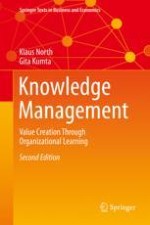2018 | OriginalPaper | Buchkapitel
8. Measuring and Safeguarding Intellectual Capital
verfasst von : Klaus North, Gita Kumta
Erschienen in: Knowledge Management
Aktivieren Sie unsere intelligente Suche, um passende Fachinhalte oder Patente zu finden.
Wählen Sie Textabschnitte aus um mit Künstlicher Intelligenz passenden Patente zu finden. powered by
Markieren Sie Textabschnitte, um KI-gestützt weitere passende Inhalte zu finden. powered by
